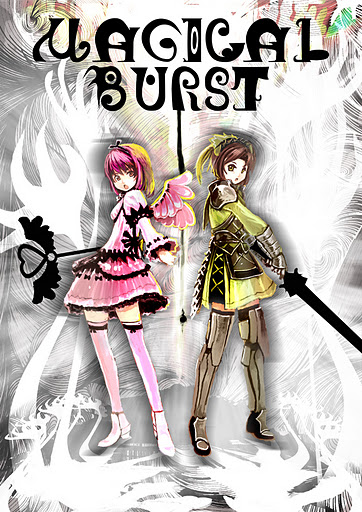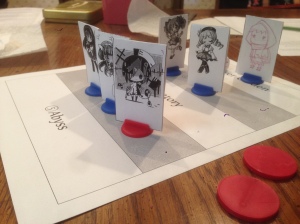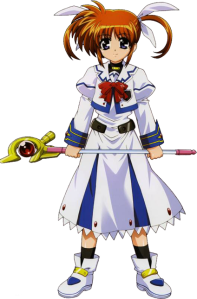I’ve sporadically gotten inspired to poke at Magical Burst, but I haven’t made a lot of progress until very recently. I posted about it a while back, but Magical Burst has two combat systems. “Skirmishes” are based on the combat rules from Magical Fury, a lightning-fast system that distills battles down to a handful of rolls and determining the consequences, while “full battles” are meant to be a tactical combat system that still generates consequences, but is also fun to play for its own sake. Shinobigami and some of Adventure Planning Service’s other recent games has a thing where there’s a “Climax Phase” to a game session where an all-out battle can happen, but otherwise clashes between characters end as soon as one character takes damage. It’s a little arbitrary perhaps, but particularly in the context of Shinobigami, it helps reinforce the genre. In the Persona games, although they use the same combat system, there’s a sharp distinction between fights with dungeon mobs and bosses. When fighting random shadows, your goal is to use their weaknesses to short-circuit things and end the battle as quickly as possible, whereas bosses are always more of an endurance test as you try to balance damage and healing. I really like having the flexibility to decide how much time you want to spend on combat in Magical Burst, because as much as I enjoy good tactical combat, I also sometimes want to just get on with the story.
Of course, that means that I’ve set myself the task of designing a tactical combat system, for the first time. Most of the RPGs I’ve designed have either minimized fighting or handled it with a more narrative approach, and while I have some really useful inspiration in D&D 4th Edition and Strike!, I needed more. I ended up looking to video games for inspiration. I went and bought a Nintendo Switch with Octopath Traveler and Mario + Rabbids Kingdom Battle.
Octopath Traveler is a recent game from Square Enix, a a 16-bit throwback reminiscent of Final Fantasy VI with modern touches, including a gorgeous “2D HD” look with sprite characters moving through a beautiful 3D world with sprite textures and extensive lighting effects.

OT has a turn-based combat system typical of old-school JRPGs, but each round, each of your characters gets a Boost Point (unless they spent BP the previous turn). You can spend these to increase the potency of the character’s actions, turning basic attacks into multi-attacks, making magic attacks more potent, making buffs last longer, and so on. Characters can store up to 6 BP and can spend up to 3 on an action, and there are a few special skills that can manipulate BP as well. (Enemies also have various vulnerabilities, and hitting them enough times with attacks they’re vulnerable to temporarily incapacitates them. This becomes a vital strategy in the game, and makes boosted basic attacks really useful beyond doing more damage.)
It’s a little bit different, but I hit on the idea of adding a currency called “Resonance” to full battles in Magical Burst. Magical girls start with 1 Resonance, and get one at the end of each round, plus (inspired by the Miss Tokens from Strike!) one when they miss with an attack. The different specializations also get bonus Resonance based on actions that relate to their roles in combat.
- I wanted to have an action economy similar to D&D4e and Strike!, but a little simpler, so I had it so that each character gets a Main Action and Support Action. Having movement be a Support Action tended to put a squeeze on the action economy though, and letting players spend a Resonance for an extra Support Action (or 3 Resonance for an extra Main Action) will hopefully alleviate that.
- With characters taking Overcharge points for both rolling too high with magical checks and for using certain Talents, there’s a significant risk of full battles generating too much Overcharge relative to other parts of the game. Letting players spend Resonance to power Talents and to negate Overcharge will allow them to manage both better when they want and take bigger risks when they feel it’s worth it.
I really hope this works out in playtesting, because it feels like a really fun mechanic that will hopefully shore up the full battle system in multiple ways.
Mario + Rabbids is turning out to be more or less exactly what I’d heard it was, which is to say XCOM Lite with Mario and Rabbids characters, which somehow results in a way better game than you’d think. Some of its core mechanics are deliberately cartoony–like how if you move one of your units into the position of one of your other units, they get catapulted to another location of your choice, letting them do a double move that ignores terrain obstacles–but it also does a good job of implementing tactics fundamentals like cover. It’s a bit weird that once you get past the prologue Mario promptly gets a gun (albeit a cartoony blaster thing) and winds up with mutant Peach and Luigi Rabbids as companions, but the game shows real skill in how it gradually introduces you to its mechanics, slowly increasing your palette of tactical considerations and options.

I’m still in the process of playing Mario + Rabbids and figuring out what to take from it, but I think the biggest take-away so far is how it makes such extensive use of terrain to create new tactical considerations. One of D&D4e’s shortcomings was that while terrain was (rightly) very important, the game needed better tools to create and use interesting terrain. As much fun as we had playing it, there were a few too many battles in mostly-empty rooms, regardless of whether or not the DM was using stuff out of modules.
Looking to video games for inspiration when designing tabletop RPGs is weird, because while video games are limited in how they can use human interaction, their mechanical aspects are much more varied, with sophistication in different places. I most likely wouldn’t have come up with something like Resonance if I’d only been looking at other RPGs for example. While in RPG design you do have to use and accommodate the conversation and the fiction, the medium has a long tradition of perhaps excessively falling back on (a certain vision of) realism.
I’ve also been working more on the youma rules, and one thing that’s been really helpful is Blog of Holding’s Monster Manual 3 on a Business Card. (There’s a 5th Edition version too by the way.) As good as D&D 4th Edition was in terms of tightly designed tactical combat, it took them until Monster Manual 3 to really nail down the math for monster stats. That’s especially true of solo monsters, which had too many hit points initially, making them a slog to fight. BoH distilled that improved math down until it could fit on one side of a business card, which lays bare the sheer simplicity of determining HP, damage, defense values, etc. once the designers figured out how to balance everything right. This is proving immensely helpful to me, especially since Magical Burst, following its source material, naturally tends towards solo monsters, which are significantly harder to design. While I think the ideas I’ve been working on (like having a “Spread” value that determines how good a youma is at fighting multiple enemies) are on the right track, I needed to see there in black and white that a solo monster outright has 4x the HP.



![IWantToBeAnAwesomeRobot[smallpdf.com]](https://yarukizero.files.wordpress.com/2014/03/iwanttobeanawesomerobotsmallpdf-com.png?w=100&h=150)



